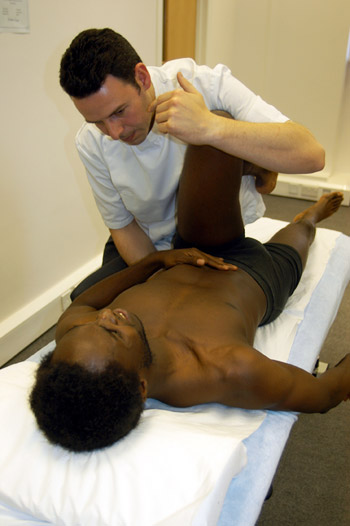
Image copyright Kampfner Photography
Osteopathy Consultation & Treatment - £60
Osteopathy Treatment - £46
Osteopathy "Mini Treatment" - £35
Osteopathy Consultation without treatment - £35
Osteopathy (medical) report - from £30
Before your first Osteopathy treatment at Absolute Health clinic, please read our New Patient Information Sheet.
Your initial consultation involves taking a medical history, performing a postural assessment and an examination of the relevant parts of your body (you may be asked to undress).
Osteopaths specialise in the diagnosis, treatment, prevention and rehabilitation of certain musculoskeletal conditions, including offering guidance on diet, lifestyle and exercise. Osteopathy is classed as complementary therapy (not involving the use of surgery or drugs) which is often used alongside traditional medicines and procedures in the UK.
If you are suffering with sciatica, back pain, neck pain, headache / migraine or other aches and pains, book in today for a consultation and treatment.
Read a report on "Quality in Osteopathic Practice" which brings together existing research on the patient experience, clinical effectiveness and safety of osteopathic practice.
Osteopathy is most commonly used to treat conditions such as:
Your first session takes about 1 hour, which allows time to take a medical history and enables your Osteopath to make a diagnosis about your condition. Treatment options will be given and with your agreement treatment will be offered on this first session.
It is common to undress (down to underwear) to allow the Osteopath to fully assess your posture, spinal and joint alignment and to assess muscle and skin condition. You may be asked to perform certain movements to demonstrate the range of movement you have.
Your Osteopath will assess your spine in more detail, usually with you lying on a treatment couch, and perform movements throughout the spine to check for restrictions and areas of tenderness.
Osteopaths commonly stretch, massage and move the body in a variety of ways using a mixture of gentle and forceful techniques designed to reduce pain and swelling, improve range of movement and aid the circulation to and from tissues and organs.
If you feel uncomfortable being undressed, or prefer a chaperone to be present during treatment, please speak to your Osteopath who will accommodate your needs.
Follow-up treatments typically take 30-45 minutes and may be required weekly or fortnightly. Commonly, 4 to 6 treatment sessions are sufficient to deal with recent (sub-acute) conditions. Chronic problems may take longer to resolve, with some patients requiring on-going treatment (every few months).
You will probably be given exercises to do after your treatment. It is very important that you perform these as instructed, and if you forget what to do, feel free to contact your Osteopath for further advice.
You may also be advised about changes to diet, lifestyle, posture, ergonomics (at a workstation) or other habits that may be contributing to your condition. The effectiveness of your treatment may be reduced if you do not follow these guidelines. If you are unsure about anything your Osteopath advises, ask them for clarification or written instructions you can follow at home or at work.
The National Institute for Health and Clinical Excellence (NICE) offers recommendations to the NHS for the treatment and care of people with specific conditions. In 2009, NICE issued clinical guidelines for "Early management of persistent non-specific low back pain". Their recommendations included Manual Therapy - "consider offering a course of manual therapy, including spinal manipulation [as performed by Osteopaths], comprising up to a maximum of nine sessions over a period of up to 12 weeks".
In 2010, Bronfort and colleagues produced a report "Effectiveness of manual therapies: the UK evidence report". The purpose of this report was to provide a comprehensive summary of the scientific evidence regarding the effectiveness of manual treatment for the management of a variety of musculoskeletal and non-musculoskeletal conditions.
Their conclusions noted that "Spinal manipulation/mobilization is effective in adults for: acute, subacute, and chronic low back pain; migraine and cervicogenic headache; cervicogenic dizziness; manipulation/mobilization is effective for several extremity joint conditions; and thoracic manipulation/mobilization is effective for acute/sub-acute neck pain. Massage is effective in adults for chronic low back pain and chronic neck pain."
In 2006, Anderson and colleagues produced a report "A Comparison of Selected Osteopathic Treatment and Relaxation for Tension-Type Headaches". They concluded that "the people in this study who did relaxation exercises and received 3 osteopathy treatments had significantly more days per week without headache than those who did only relaxation exercises".
In a 2005, Licciardone and colleagues produced a report "Osteopathic manipulative treatment for low back pain: a systematic review and meta-analysis of randomized controlled trials". Their meta-analysis and systematic review of six randomized controlled trials of osteopathic manipulative treatment (OMT) that involved blinded assessments of lower back pain in ambulatory settings, concluded that OMT significantly reduces lower back pain, and that the level of pain reduction is greater than expected from placebo effects alone and persists for at least three months.
